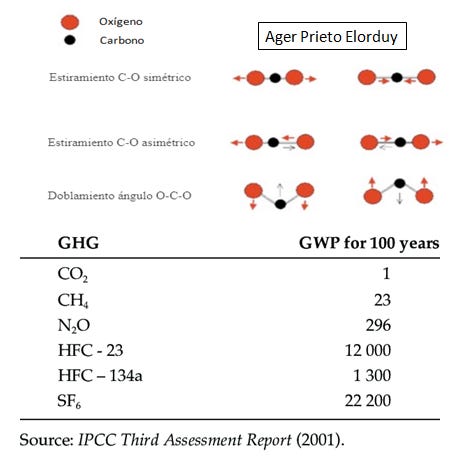60) ¿Motivo por el que unos gases calientan la atmósfera y otros no? - Gases de efecto invernadero
Hubo un momento en la historia del planeta, en el que el efecto invernadero fue clave para que la vida humana floreciera como lo ha hecho hasta alcanzar una población mundial de 8000M este 2022.
Cabe destacar, que el efecto invernadero es un fenómeno natural y hasta cierto punto beneficioso para el ser humano. Sin él, la temperatura media del planeta sería -19ºC, en vez de 15ºC actuales.
Hace 25 años se firmó el protocolo de Kioto, donde se describieron 6 gases (CO₂, CH₄, N₂O, HFC, PFC y SF₆) que contribuyen al efecto invernadero, al retener parte de la radiación térmica emitida por la superficie terrestre tras ser calentada por el sol.
La energía de los fotones de la luz infrarroja emitida por el planeta, es absorbida por las moléculas, almacenándose en forma de energía vibracional y rotacional de sus núcleos. Pero para ello, se tiene modificar el momento dipolar durante el movimiento de oscilación vibracional. Dicho de otra manera, se tiene que descompensar su momento dipolar (es decir, se tiene que romper esa simetría que lo anula).
Los 6 gases arriba descritos absorben la luz infrarroja, sufriendo oscilaciones entre los átomos, y por tanto viéndose alterada la distancia entre ellos. Cuando las moléculas dejan de estar en esos estados excitados de vibración, vuelven a emitir en todas direcciones radiación infrarroja a la atmósfera, traduciéndose en un aumento de T.
El aire al estar compuesto principalmente por N₂ y O₂ (moléculas diatómicas y lineales), solo tiene un enlace que une a los 2 átomos. Las oscilaciones entre esos 2 átomos, hace que el momento dipolar sea nulo, por que se van a contrarrestan entre sí. Es por ello, no contribuyen al efecto invernadero.
Al analizar el CO₂ (imagen), podemos comprobar que posee diferentes vibraciones como son 1) Estiramiento C-O simétrico, 2) Estiramiento C-O asimétrico y 3) Doblamiento ángulo O-C-O.
El 2) y 3) si pueden ser excitados, y esas vibraciones le posibilitan al CO₂ absorber los fotones de luz infrarroja. Ese es el motivo por el cual moléculas como CO₂, CH₄ o N₂O absorben luz infrarroja y al dejar de estar excitados, devuelven fotones calentando la atmósfera.
Pero NO todos los gases de efecto invernadero contribuyen de la misma manera al calentamiento de la atmósfera. Para ello, se creó un parámetro llamado Global Warming Potencial, GWP (https://lnkd.in/e7sHjSy6)); siendo este índice una medida relativa de cuanto calor puede ser atrapado por un determinado gas de efecto invernadero, en comparación con un gas de referencia, CO₂.
Este índice nos da una información útil, ya que muchas veces centramos nuestras miradas en el CO₂ como principal causante del calentamiento climático. Pero a 100 años vista el efecto de metano es 23 veces mayor, aunque su concentración atmosférica es 220 veces menor (metano 1,90 ppm y CO₂ 419 ppm) (https://lnkd.in/eRNMU-SE).
60) What is the reason why some gases heat the atmosphere and others do not? - Greenhouse gases
Reason why some gases warm the atmosphere and others don't? There was a moment in the history of the planet, in which the greenhouse effect was key for human life to flourish as it has done until reaching a world population of 8000M this 2022.
It should be noted that the greenhouse effect is a natural phenomenon and to some extent beneficial to humans. Without it, the planet's average temperature would be -19ºC, instead of the current 15ºC.
25 years ago the Kyoto protocol was signed, where 6 gases (CO₂, CH₄, N₂O, HFC, PFC and SF₆) were described that contribute to the greenhouse effect, by retaining part of the thermal radiation emitted by the earth's surface after being heated by Sun.
The energy of the photons of the infrared light emitted by the planet is absorbed by the molecules, being stored in the form of vibrational and rotational energy of their nuclei. But for this, the dipole moment must be modified during the vibrational oscillation movement. In other words, its dipole moment must be unbalanced (that is, the symmetry that cancels it must be broken).
The 6 gases described above absorb infrared light, undergoing oscillations between the atoms, and therefore the distance between them is altered. When the molecules are no longer in these excited states of vibration, they re-emit infrared radiation in all directions into the atmosphere, resulting in an increase in T.
Air being composed mainly of N₂ and O₂ (diatomic and linear molecules), only has one bond that joins the 2 atoms. The oscillations between those 2 atoms makes the dipole moment zero, because they will counteract each other. That is why they do not contribute to the greenhouse effect.
When analyzing CO₂ (image), we can verify that it has different vibrations such as 1) symmetrical C-O stretching, 2) asymmetrical C-O stretching and 3) O-C-O angle doubling.
2) and 3) can be excited, and these vibrations make it possible for CO₂ to absorb photons of infrared light. That is the reason why molecules such as CO₂, CH₄ or N₂O absorb infrared light and, when they are no longer excited, they return photons, heating the atmosphere.
But NOT all greenhouse gases contribute in the same way to warming the atmosphere. For this, a parameter called Global Warming Potential, GWP (https://lnkd.in/e7sHjSy6)) was created; this index being a relative measure of how much heat can be trapped by a certain greenhouse gas, compared to a reference gas, CO₂.
This index gives us useful information, since many times we focus our eyes on CO₂ as the main cause of climate warming. But 100 years from now, the effect of methane is 23 times higher, although its atmospheric concentration is 220 times lower (methane 1.90 ppm and CO₂ 419 ppm) (https://lnkd.in/eRNMU-SE).






